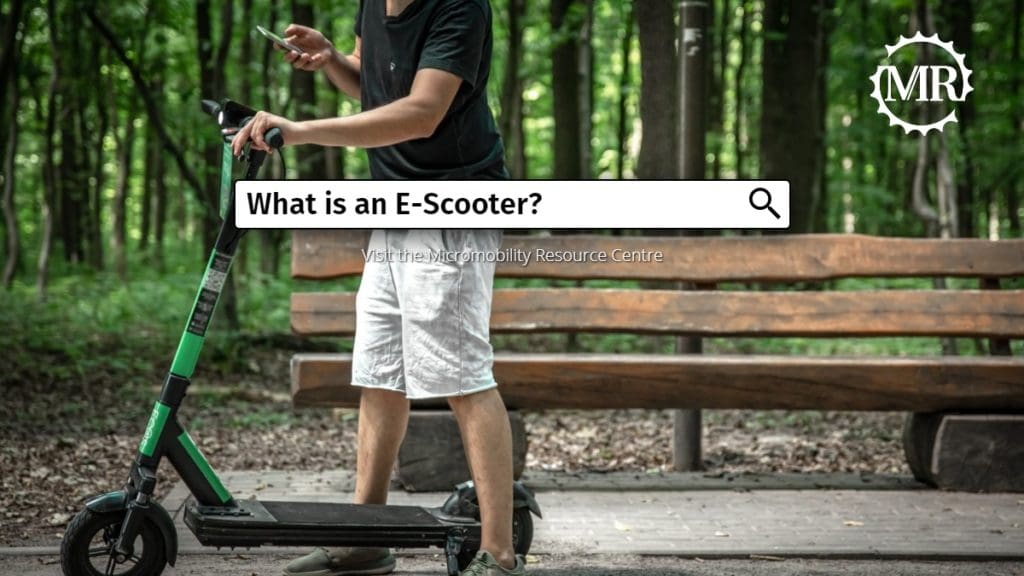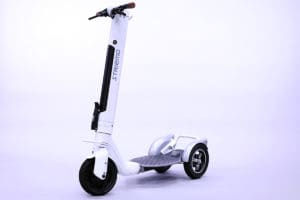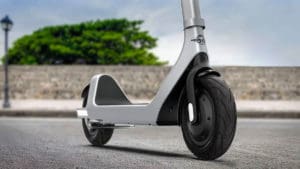What is an e-Scooter?

At the Micromobility Report, we explain what an e-Scooter is, how they work, and answer your frequently asked questions.
An e-scooter is an electric-powered two-wheeled personal mobility device. They usually have a battery either under the foot platform or within the head tube and a small electric motor that drives the rear wheel.
The scooters that are legal in the ACT and Queensland are limited to a maximum speed of 25 kph and a maximum weight (excluding the rider) of 60 kg, although many scooters are much lighter than this.
There are e-scooters available for sale in Australia that are much more powerful and faster than this, but these are only legal for use on private land, and will probably remain so for the indefinite future. This will most likely be the case even after the other states legalise 25kph scooters.
However, it is legal for retailers to sell these faster scooters in Australia, even though they are not legal to be ridden on public roads. In order to limit their liability, the retailers usually advise the purchaser that the scooter cannot be legally ridden on public roads. In some cases, they require the purchasers to sign a document acknowledging that they’ve been told this and understand that they will be breaking the law if they ride the scooter anywhere other than on private land.
“…it’s up to each state government to adopt the new model rules within their own state’s regulations. This is ultimately a political decision, so there are no guarantees, but we think that e-scooters meeting the framework will be legal within most states by 2023.”
Why Can’t e-Scooters Be Used on Public Roads?
The answer depends upon where you live and what type of scooter that you’re talking about. Scooters are currently (as of October 2021) only legal to ride on roads and paths in Queensland and the ACT.
In various cities in other states and territories around Australia, scooter-share programs are currently running, with more about to start. In these cases, the relevant government authorities are making special exemptions in their regulations to allow the scooter-share schemes to operate.
Progress is being made towards scooters becoming legal everywhere. The National Transport Commission (NTC) a federal government body, has done the research and created a framework for including personal mobility devices including e-scooters into the Australia Road Rules.
This framework has been endorsed by a meeting of transport ministers from each state and territory.
Because our transport and road rules are largely regulated at the state and territory level, it’s now up to each state government to adopt the new model rules within their own state’s regulations. This is ultimately a political decision, so there are no guarantees, but we think that e-scooters meeting the framework will be legal within most states by 2023.
This will not apply to high powered scooters that can travel at over 25 kph. These devices are already widely available. Some can travel as fast as 100 kph and others at 45 kph or 60 kph.
These can be legally sold but can only be legally ridden on private land.
Who Supports Legalising e-Scooters?
There are many grassroots local organisations that are campaigning, not just for the legalisation of electric scooters, but for other personal mobility devices such as e-unicycles and e-skateboards.
Electric Riders Australia (ERA) is a national group that many of these local and state-based groups are affiliating with. You can read a detailed interview with Jonno Sea, the Chair of ERA, in which he gives an overview of the current situation on legalising e-Scooters.
As you would expect, those in the businesses of manufacturing, importing and selling e-scooters and related personal mobility devices are also keen to see them legalised.
You can read an interview with the owner of Australia’s largest retail chain, Scooter Hut.
Help us share the latest micromobility news with others…
Join us on social media
What’s Next?
Like all electronics based products, you can expect e-scooters to progressively improve. Battery range will continue to increase and motors will become smaller, quieter, smoother and lighter. Best of all, prices should eventually decrease, particularly as batteries, which are the most expensive component, come down in price.
As our transport rules and legislation begin to recognise e-scooters as valuable micromobility vehicles and approve their use in more of our streets, the demand for the new and emerging technologies will also increase.
Would you like to read more stories about e-scooters?
About the Micromobility Report
Every new activity needs a forum through which its new products and the latest trends can be shared and discussed. The Micromobility Report aims to be that forum, under the tag line, ‘Go Further With Less’.
Its content is arranged under four main menus:
- Products will cover every relevant form of bike, scooter and other LEV (light electric vehicle).
- Infrastructure will cover a wide range of topics including bike and scooter share systems, end of trip facilities, integration & data, planning, design & education, policy & funding, mobility as a service (MAAS) and more.
- Recreation will include all forms of micromobility tourism and recreation including rail trails and MTB parks.
- Features will include the latest companies and products, Annual Guides focused on key micromobility topics and opinion articles.
Want to stay in the loop with industry news and updates? The Micromobility Report has a free monthly newsletter to keep you informed. Subscribe Now!







